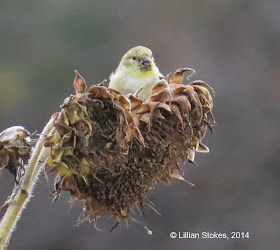
Cackling Goose, hutchinsii subspecies
All above photos, Cackling Goose, hutchinsii subspecies
Cackling Geese create excitement for birders when they show up in the East, and there is one being seen in Maine now. Look carefully when you see a flock of Canada Geese, and maybe you can find a Cackling Goose! See my other
blog post here. These geese, who mainly nest in the arctic, look like very small Canada Geese, but are a different species. There are 4 subspecies of Cackling Goose. It is thought that the subspecies who usually shows up in the East is the nominate subspecies,
Branta hutchinsii hutchiinsii, (also sometimes called "Richardson's Goose", "Richardson's Cackling Goose" or "
Hutchins's Goose"). The above are photos I took in western Massachusetts on 11/8/09 is of the
hutchinsii subspecies (confirmed by experts). ID of Cackling subspecies emphasizes head and bill shape, with hutchinsii having a ratio of bill length to depth of about 3:2. This bird in my photo has a short bill, a short, steeply rising forehead, a rather flattened crown rising to a bit of a peak at the back of the head, all characteristics of the
hutchinsii subspecies. Most
hutchinsii also have a narrowing of the white of the cheek patch at the level of the eye, also visible on this bird. This bird also has a very pale breast, as have the majority of
hutchinsii. The back and sides are also pale, the back does not appear darker than the sides. There's noticeable pale edges to the wing covert feathers, creating pale diagonal lines.

Cackling Goose, unknown subspecies
Cackling Geese cannot always be identified as to subspecies, as with the above and following photos of an
individual I photographed in Ohio (east of Toledo) in May 2005. Several experts concur that this might be a
hutchinsii subspecies or possibly an
intergrade between the
taverneri and
hutchinsii subspecies, but it cannot be definitively identified. To quote the excellent article on Distribution and Identification of Cackling Goose Subspecies by
Mlodinow et al. "though birds breeding on the continental Arctic slope from the Mackenzie River west are thought to be
taverneri, the precise border between
taverneri and nominate
hutchinsii has not been defined, nor has the degree of potential or actual
intergradation between the two (J.
Leafloor, J. Pearce, D.
Derksen,
pers. comm.)."

This bird shows a more rounded head than the
hutchinsii bird in my top photo, with a more gradual slope from the bill to the head, more characteristic of
taverneri.
Taverneri subspecies have "stout and somewhat triangular bills". The breast of this bird is pale.
Taverneri are "typically medium-gray-breasted, becoming darker on belly/flanks" according to the article. However, sometimes they can have pale breasts.

Here's the neck fully upright in an alert posture of the goose. The head looks faintly flattened and there's white flecking at base of the black neck, suggesting a very thin white neck collar. The article estimated that only 2-5% of
taverneri adults have a neck collar and that about 10-20% of
hutchinsii can have a neck collar.

Here's another posture with the head looking somewhat flattened. Note that under the chin you can see a thin black line running from bill to the black neck, called a
gular stripe. This is sometimes seen in a small percentage of
hutchinsii, whereas 40-75% of
taverneri have a
gular stripe according to the article.

Here's another posture where the neck looks short.
Cackling Geese of the
hutchinsii subspecies mainly winter along the Gulf Coast from
southeastern Louisiana down into Mexico and also from eastern Colorado to eastern New Mexico through western Texas and into Mexico. Of the Cackling Geese that show up outside of their normal wintering range and stray to the East in small numbers, almost all reports have been of the
hutchinsii subspecies. They have been reported from Indiana, Ontario, western New York, southern Quebec and Nova
Scotia down to Virginia with a few reports to North Carolina, South Carolina and a few from Florida.
Taverneri subspecies winters in mainly Washington and Oregon, although some may winter in the continent's center. There are few reports of
taverneri in eastern North America. There's a record from Onondaga county, New York, Sept. 2004,
Janesville, Wisconsin, Oct. 2004, Amherst, Mass. Oct. 2007 and maybe the same bird in
Middlefield Conn. Nov. to Dec. 2007 for photos of this bird see
here.
The other two subspecies of Cackling Geese are leucoparia and minima. Minima (called Ridgway's Goose) is the smallest and darkest of the subspecies and winters mainly in western Oregon and Washington and central California. Only a handful or so of reports for minima exist for east of the Mississippi and are for North Carolina, Illinois, Connecticut, Alabama, Virginia and Tennessee. Leucoparia (called Aleutian Goose) a medium-sized Cackling, has a broad, white, complete neck collar on all adults. It winters mainly California and a little in Oregon and there are no winter records for east of the Mississippi River that we know of.
So keep looking at Cackling Geese in the East, there may be other subspecies showing up besides hutchinsii. If you find them, let us know.
For more complete information and photos of all 4 subspecies, see our
The Stokes Field Guide to the Birds of North America, page 12.
Also consult Distribution and Identification of Cackling Goose Subspecies, by Mlodinow et al. North American Birds, vol. 62, no. 3, 2008, pages: 344-360.









































